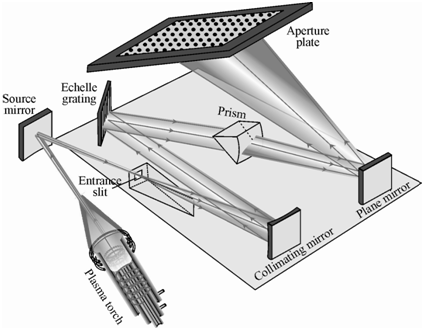Polychromators:
These simultaneous spectrometers are designed with a fixed diffraction grating monochromator and multiple 'exit slits' and associated photomultipliers. It means that these spectrometers have a number of photomultiplier tubes. Each of the photomultiplier is optimised to detect a specified wavelength corresponding to an element of interest. Typically, about 60 photomultiplier tubes or detectors are installed in a polychromator. Therefore, the simultaneous measurement of a prespecified range of elements becomes extremely rapid. A schematic diagram showing a setup of a polychromator is provided in Figure.
In Echelle spectrometers a special configuration of diffraction grating is used that displays the entire spectrum as a 2D array, every line in the array representing a particular multiple sequence of diffraction. A schematic diagram of this spectrometer based on Echelle grating is shown in Figure.

Figure: A schematic diagram showing the layout and optical diagram of a spectrometer based on Echelle grating
The monochromators used here are very compact and offer particular advantages in concurrent detection. These spectrometers are faster, more precise and accurate for a given combination of analytes and interferants.
The major drawback of the simultaneous spectrometers or direct readers as these are generally called is related to the lack of flexibility. One has to make a detector available for each analyte of interest which makes it very expensive. Further, if a newer analyte sample is to be analysed one needs to procure new detectors for the same and augment the battery of the detectors present in the instrument. Additionally, if a new matrix is encountered, one or more of the analytical lines might have severe spectral interferences or background shifts. This might compromise along with the precision and accuracy of the system.